
The Dublin Area Rapid Transit system is an electrified commuter rail railway network serving the coastline and city of Dublin, Ireland. The service makes up the core of Dublin's suburban railway network, stretching from Greystones, County Wicklow, in the south to Howth and Malahide in north County Dublin. The DART serves 31 stations and consists of 53 route kilometres of electrified railway, and carries in the region of 20 million passengers per year. In a similar manner to the Berlin S-Bahn, the DART blends elements of a commuter rail service and a rapid transit system.
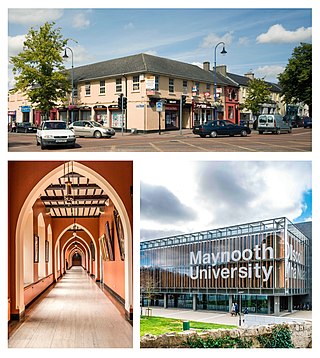
Maynooth is a university town in north County Kildare, Ireland. It is home to Maynooth University and St Patrick's College, a Pontifical University and Ireland's sole Roman Catholic seminary. Maynooth is also the seat of the Irish Catholic Bishops' Conference and holds the headquarters of Ireland's largest development charity, Trócaire. Maynooth is located 24 kilometres west of central Dublin.

Connolly station or Dublin Connolly is one of the busiest railway stations in Dublin and Ireland, and is a focal point in the Irish route network. On the North side of the River Liffey, it provides InterCity, Enterprise and commuter services to the north, north-west, south-east and south-west. The north–south Dublin Area Rapid Transit (DART) and Luas red line light rail services also pass through the station. The station offices are the headquarters of Irish Rail, Iarnród Éireann. Opened in 1844 as Dublin Station, the ornate facade has a distinctive Italianate tower at its centre.

Kent Station is an Iarnród Éireann railway station in Cork, Ireland. Originally opened in 1893, the station operates as a hub for Intercity services to Dublin and Tralee and commuter services to Mallow, Cobh and Midleton. In 2016, Kent Station was the fifth busiest station in the Republic of Ireland, as well as the busiest outside of Dublin.

The Belfast–Dublin Main Line is a main and the busiest railway route on the island of Ireland that connects Dublin Connolly station in the Republic of Ireland and Belfast Lanyon Place station in Northern Ireland. It is the only railway line that crosses the Republic of Ireland–United Kingdom border.
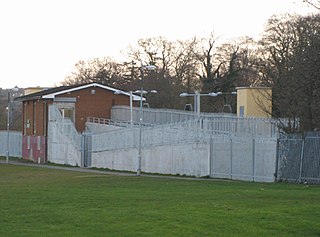
Shankill railway station serves Shankill, in Dún Laoghaire–Rathdown, Ireland.

Malahide railway station serves Malahide in Fingal.

Leixlip Louisa Bridge is a railway station in the north-eastern corner of County Kildare, Ireland. It is one of two stations that serve the civil parish of Leixlip, the other being Leixlip Confey. Both stations lie on the Dublin to Maynooth commuter route. It is one of the few stations in the Iarnród Éireann network in which the station building is located directly over the platforms, on a bridge.
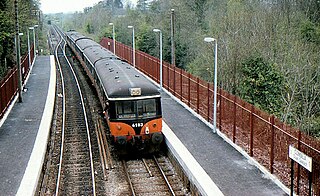
Clonsilla railway station is a railway station that serves Clonsilla, in Fingal, Ireland.

Coolmine railway station serves Coolmine, County Dublin, Ireland.
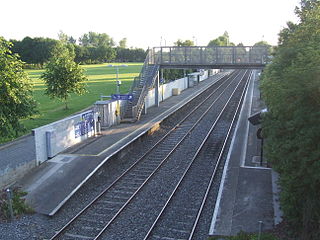
Castleknock is a railway station that serves the suburban centres of Castleknock and Blanchardstown in Fingal, Ireland.
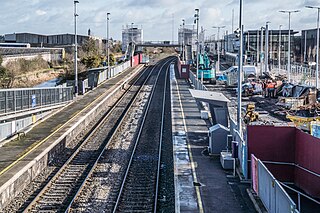
Broombridge is a railway station beside a Luas Tram stop serving Cabra, Dublin 7, Ireland. It lies on the southern bank of the Royal Canal at the western end of what had been Liffey Junction station on the erstwhile Midland Great Western Railway (MGWR). It takes its name from Broome Bridge, which crosses the canal, where William Rowan Hamilton developed the mathematical notion of quaternions. A plaque on the adjacent canal bridge and the name of the Luas Maintenance depot on site, Hamilton Depot, commemorates this.
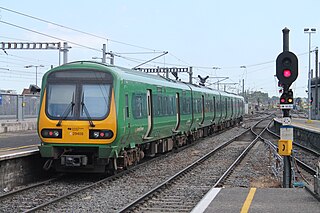
The Dublin Suburban Rail network, branded as Commuter, is a railway network that serves the city of Dublin, Ireland, most of the Greater Dublin Area and outlying towns. The system is made up of five lines:

InterCity is the brand name given to rail services operated by Iarnród Éireann that run between Dublin and other major cities in Ireland. InterCity branding is also used in other European countries by unaffiliated organizations.

This article deals with transport in the Greater Dublin Area centred on the city of Dublin in Ireland.
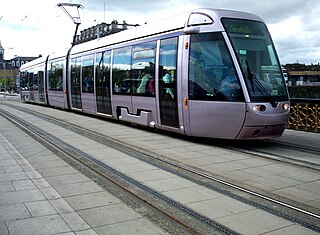
Public transport in Ireland exists in many of the Ireland's urban areas and rural areas, and takes a number of forms. Bus transport is the main form of public transport and is common in all cities. The cities, Dublin, Belfast, Cork, Limerick and Galway all have their own suburban rail networks, although Dublin is the only to have its own tram line, in the form of the Luas. Ireland has a population of 5 million people.

Hansfield railway station is a railway station in Fingal, Ireland. It lies on the Docklands to M3 Parkway Commuter service and serves housing estates including Hansfield, Ongar, Littlepace, and Barnwell, among others; it is also the station nearest Clonee.

Navan railway station is a former train station which served the town of Navan in County Meath, Ireland.

Leixlip is a town in north-east County Kildare, Ireland. Its location on the confluence of the River Liffey and the Rye Water has marked it as a frontier town historically: on the border between the ancient kingdoms of Leinster and Brega, as an outpost of The Pale, and on Kildare's border with County Dublin. Leixlip was also a civil parish in the ancient barony of Salt North.
Leixlip is a civil parish and a townland located in the north-eastern corner of County Kildare, Ireland. The civil parish is mainly in the ancient barony of Salt North with a small part in the neighbouring barony of Newcastle. It is centred on the town of Leixlip. In geology, the parish rests on a substratum of limestone, and contains chalybeate springs. It lies at the confluence of the River Liffey and the Rye Water.





















